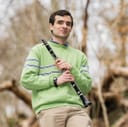Stay in the Loop
BSR publishes on a weekly schedule, with an email newsletter every Wednesday and Thursday morning. There’s no paywall, and subscribing is always free.
More than spectacle
Bowerbird presents 'Sound Machines,' featuring Mauricio Kagel's 'Zwei Mann Orchester'

The Bowerbird exhibition Sound Machines brings Argentinian-German composer Mauricio Kagel’s Zwei Mann Orchester in all its Rube Goldbergian glory to Drexel University’s Pearlstein Gallery this month. It's just the type of work that suits Bowerbird, a presenter of experimental music: the more offbeat, the better.
Kagel created the piece from 1971 to 1973. Lasting about 45 minutes, it consists of an enormous kinetic sculpture of musical instruments and found objects activated by just two musicians, constructed on three platforms that span the expansive gallery space.
While Kagel does not offer precise instructions for assembling the spectacle, he puts a handful of restrictions on musicians. For example, they may not leave the bench where they are seated. This necessitates an ingenious system of pulleys, levers, and gadgets to reach the farthest instruments.
Each iteration of the piece will be different, and the Philadelphia iteration is only the fourth time it has been performed since its inception, and the first outside of Europe. For this U.S. premiere, it is performed by local percussionists Andy Thierauf and Ashley Tini on a sculpture assembled by Thierauf, Tini, Neil Feather, Scott Kip, Yona Davidson, and Bowerbird artistic director Dustin Hurt.
It is not possible for the two musicians to play every instrument at once. As a result, the music consists of brief periods of contrasting sound combinations. A warm, lush cello opening; an expansive, leisurely duet of two jack-in-the-boxes; a pensive display of rotating violins and gongs — there’s a lot happening here!
Many of these sections sound delicate, but the overall impression is a sense of fun and playfulness. Plenty of sections are liable to make the audience laugh; some are rather beautiful; and for several of the sections, both are true.
Zwei Mann Orchester runs into the same challenge other percussion solo or concerto pieces can occasionally face: with so many instruments played by so few people, there can be a sense of visiting an instrument zoo or demonstration, more than listening to a cohesive work of music.
We see a couple of instruments in action for one brief section, then we see a few more in the next section, and so on. After one listening, I did not sense a cohesive shape, flow, or progression to the piece. I would have welcomed any of those elements, though perhaps a “museum of instruments” aesthetic is more appropriate for the sculpture than a unified sound, especially when presented in an art-gallery space.
Nevertheless, this is far from the empty spectacle one might imagine such a piece becoming; each section of music remains deeply sonically compelling on its own. Ultimately, Zwei Mann Orchester offers a thoroughly joyful and eye-catching experience. It’s impressively assembled and performed.
It is also the sort of piece that after one viewing, begs to be shared with all one’s friends and is even well worth seeing — and hearing — more than once.
What, When, Where
Sound Machines. Zwei Mann Orchester, by Mauricio Kagel. Performed by Andy Thierauf and Ashley Tini. Bowerbird. Through May 24, 2018, at Drexel University's Pearlstein Gallery, 3417 Filbert Street, Philadelphia. (267) 231-9813 or bowerbird.org.
Sign up for our newsletter
All of the week's new articles, all in one place. Sign up for the free weekly BSR newsletters, and don't miss a conversation.

 Benjamin Safran
Benjamin Safran